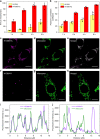Nanoscale metal-organic frameworks for mitochondria-targeted radiotherapy-radiodynamic therapy
- PMID: 30333489
- PMCID: PMC6193046
- DOI: 10.1038/s41467-018-06655-7
Nanoscale metal-organic frameworks for mitochondria-targeted radiotherapy-radiodynamic therapy
Abstract
Selective delivery of photosensitizers to mitochondria of cancer cells can enhance the efficacy of photodynamic therapy (PDT). Though cationic Ru-based photosensitizers accumulate in mitochondria, they require excitation with less penetrating short-wavelength photons, limiting their application in PDT. We recently discovered X-ray based cancer therapy by nanoscale metal-organic frameworks (nMOFs) via enhancing radiotherapy (RT) and enabling radiodynamic therapy (RDT). Herein we report Hf-DBB-Ru as a mitochondria-targeted nMOF for RT-RDT. Constructed from Ru-based photosensitizers, the cationic framework exhibits strong mitochondria-targeting property. Upon X-ray irradiation, Hf-DBB-Ru efficiently generates hydroxyl radicals from the Hf6 SBUs and singlet oxygen from the DBB-Ru photosensitizers to lead to RT-RDT effects. Mitochondria-targeted RT-RDT depolarizes the mitochondrial membrane to initiate apoptosis of cancer cells, leading to significant regression of colorectal tumors in mouse models. Our work establishes an effective strategy to selectively target mitochondria with cationic nMOFs for enhanced cancer therapy via RT-RDT with low doses of deeply penetrating X-rays.
Conflict of interest statement
W.L. is founder of RiMO Therapeutics, which licensed the nMOF technology from the University of Chicago. The remaining authors declare no competing interests.
Figures






Similar articles
-
Nanoscale Metal-Organic Layers for Radiotherapy-Radiodynamic Therapy.J Am Chem Soc. 2018 Dec 12;140(49):16971-16975. doi: 10.1021/jacs.8b11593. Epub 2018 Nov 28. J Am Chem Soc. 2018. PMID: 30485084
-
Nanoscale Metal-Organic Frameworks for Cancer Immunotherapy.Acc Chem Res. 2020 Sep 15;53(9):1739-1748. doi: 10.1021/acs.accounts.0c00313. Epub 2020 Aug 18. Acc Chem Res. 2020. PMID: 32808760 Free PMC article.
-
Hybrid-Ligand Metal-Organic Frameworks Enabling Radio-Radiodynamic-Chemodynamic Therapy Primes Checkpoint Blockade Immunotherapy in Hypoxic Tumors.ACS Nano. 2025 Aug 26;19(33):30100-30114. doi: 10.1021/acsnano.5c06188. Epub 2025 Aug 13. ACS Nano. 2025. PMID: 40802503
-
Photodynamic Therapy Based on Nanoscale Metal-Organic Frameworks: From Material Design to Cancer Nanotherapeutics.Chem Asian J. 2018 Nov 2;13(21):3122-3149. doi: 10.1002/asia.201801221. Epub 2018 Oct 12. Chem Asian J. 2018. PMID: 30183134 Review.
-
Nanoscale Metal-Organic Frameworks Generate Reactive Oxygen Species for Cancer Therapy.ACS Cent Sci. 2020 Jun 24;6(6):861-868. doi: 10.1021/acscentsci.0c00397. Epub 2020 May 15. ACS Cent Sci. 2020. PMID: 32607433 Free PMC article. Review.
Cited by
-
Monte Carlo Simulation-Guided Design of a Thorium-Based Metal-Organic Framework for Efficient Radiotherapy-Radiodynamic Therapy.Angew Chem Int Ed Engl. 2022 Nov 14;61(46):e202208685. doi: 10.1002/anie.202208685. Epub 2022 Oct 17. Angew Chem Int Ed Engl. 2022. PMID: 36149753 Free PMC article.
-
Biodegradable Metal Organic Frameworks for Multimodal Imaging and Targeting Theranostics.Biosensors (Basel). 2021 Aug 27;11(9):299. doi: 10.3390/bios11090299. Biosensors (Basel). 2021. PMID: 34562889 Free PMC article. Review.
-
Probing the optical properties and toxicological profile of zinc tungstate nanorods.J Chem Phys. 2024 Jun 21;160(23):234701. doi: 10.1063/5.0209935. J Chem Phys. 2024. PMID: 38884404 Free PMC article.
-
Advances of hafnium based nanomaterials for cancer theranostics.Front Chem. 2023 Nov 24;11:1283924. doi: 10.3389/fchem.2023.1283924. eCollection 2023. Front Chem. 2023. PMID: 38075497 Free PMC article. Review.
-
Recent advances in developing active targeting and multi-functional drug delivery systems via bioorthogonal chemistry.Signal Transduct Target Ther. 2022 Dec 2;7(1):386. doi: 10.1038/s41392-022-01250-1. Signal Transduct Target Ther. 2022. PMID: 36460660 Free PMC article. Review.
References
Publication types
MeSH terms
Substances
Grants and funding
LinkOut - more resources
Full Text Sources
Other Literature Sources
Medical
Research Materials
Miscellaneous

